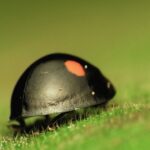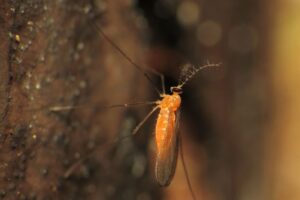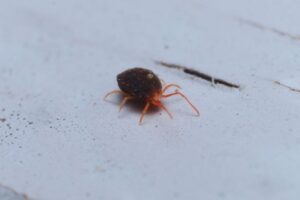You feel a slight itching sensation on your skin as if an insect had bitten you. But when you look around, all you see are tiny particles of lint floating around – or are they? You may have seen them crawling on your plants, getting on your clothes, or stuck in your hair. But what exactly are these little white bugs that look like lint?
If you see tiny dust-like creatures occurring at the beginning of every fall season, the chances are that these are aphids. Most of them don’t bite, but other little white bugs look like lint and bite that appear for the rest of the year. They could cause serious health risks from allergies and respiratory disorders.
Read on to know more about little white bugs that look like lint and bite.
Little White Bugs That Look Like Lint (and Bite)
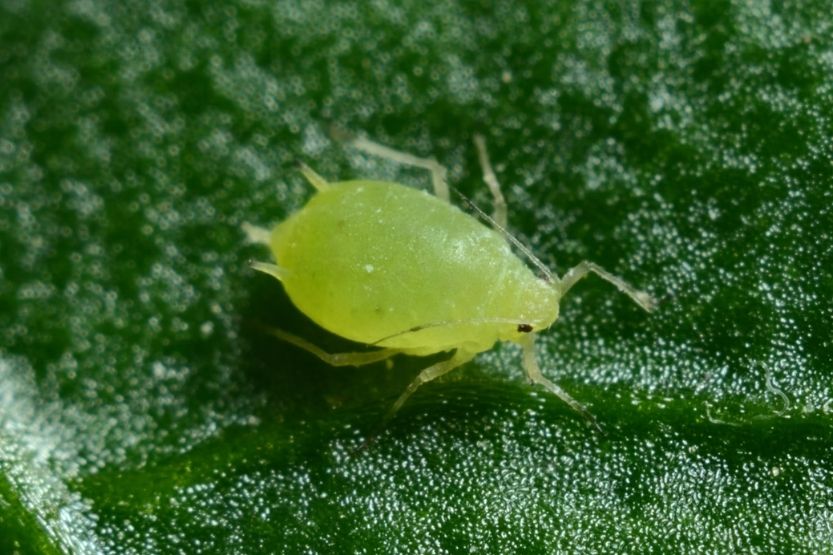
If you see tiny dust-like creatures occurring at the beginning of every fall season, the chances are that these are aphids. Most of them don’t bite, but other little white bugs look like lint and bite, which appear for the rest of the year. Unfortunately, they could cause serious health risks from allergies and respiratory disorders.
There are many kinds of little white bugs that look like lint. Some of them bite while some don’t. Let’s talk about some of these kinds and learn more about their features.
These include the following:
- Aphids
- Wooly Aphids
- Dust Mites
- Mold Mites
- Whiteflies
- Mealybugs
- Termites
- Clothes Moth Larvae
- Psocids
1. Aphids
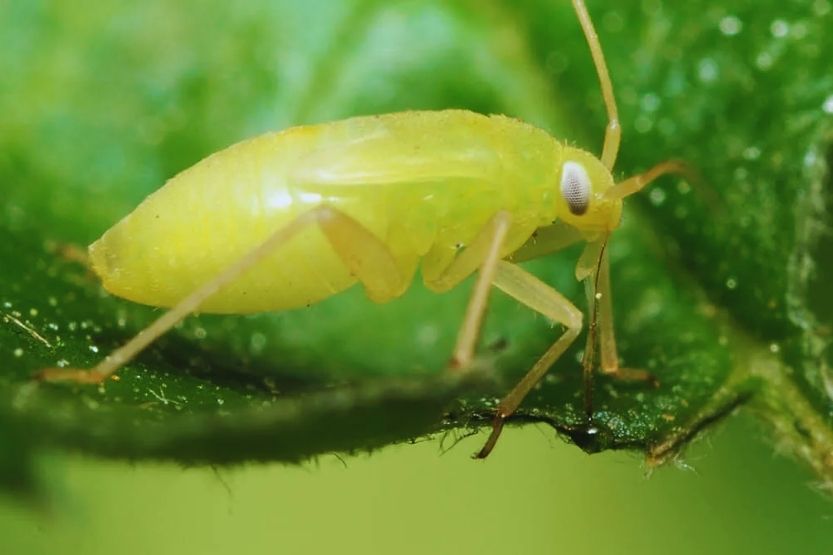
Aphids look like tiny pieces of cotton. They are typically active around the start of the fall season. This is because the drop in temperature and moisture levels are conducive to their survival.
Aphids don’t bite, nor do they eat away at plants. However, they do suck out sap from plants. They leave behind a sugary substance that resembles black mold, also known as sooty mold, which settles on plants and other substances.
Tiny Lime Green Bug – What Is It?
2. Woolly Aphids
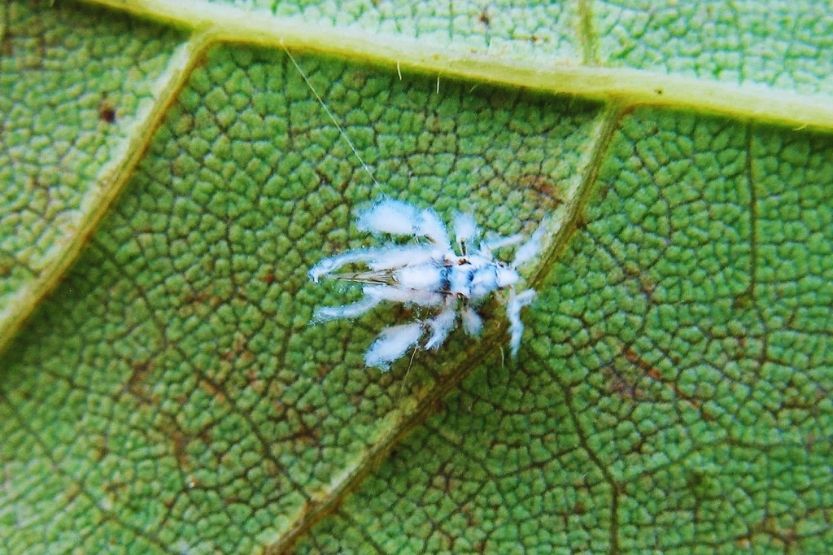
Attack Chinese Hackberry Trees
Fuzzy white wing, wooly aphids that resemble a tiny lint measure only one-tenth of an inch. They are commonly found in Florida, Illinois, and Texas. Although they attack Chinese Hackberry trees, they don’t cause any lasting damage.
Produce a Pale Wax
Woolly aphids produce a pale wax, an early sign of an infestation. They also produce honeydew, which causes mold to form on the leaves and branches of the Hackberry tree.
Cut off Leaves and Branches
Also, woolly aphids don’t cause any permanent damage to the trees, so you don’t necessarily have to get rid of them. But, for sure, you sometimes don’t want them to leave sticky molds on your plants. You can get rid of them by cutting off the infected leaves and branches.
Seasonal and Relatively Harmless
Aphids are seasonal and relatively harmless. But other kinds of little white bugs look like lint present throughout the year and are harmful, not just to plants. But they are harmful to human health as well.
3. Dust Mites

Dust and Moisture Attracts Them
Dust mites breed in moldy environments due to the dust and moisture. Also known as house mites, they usually infest clothes and soft furnishings in the household, such as sofas, carpets, and beds. Dust mites are often confused for bed bugs because of their similar habitat. Also, like bed bugs, they bite.
Spread Very Quickly
Dust mites spread very quickly, mainly because they have a steady food supply with human skin. Dust mites do bite since they feed on dry and dead skin cells. But their mouths are too weak to penetrate the skin entirely, so their bites aren’t painful. All you’ll feel is a slight pinch.
Feces Can Cause Allergic Reaction
However, that doesn’t mean they are not dangerous. The feces they leave behind on the skin can cause allergic reactions and respiratory problems. Unfortunately, it can pose a serious health risk to children and the elderly, particularly those who have asthma.
Clean Your Home to Rid of Infestation
If you or anyone in your home starts experiencing allergic or respiratory attacks, consult your doctor as soon as possible. Clean your home to rid it of possible dust mite infestation. Dust and vacuum your home regularly, and wash your clothes and sheets in warm water.
Steam Cleaning Is Effective in Killing Dust Mites
Steam cleaning is particularly effective in killing dust mites and biting pests like fleas and bedbugs. Have a window screen mesh installed to keep dust mites out, or have your house fumigated to get rid of them:
4. Mold Mites
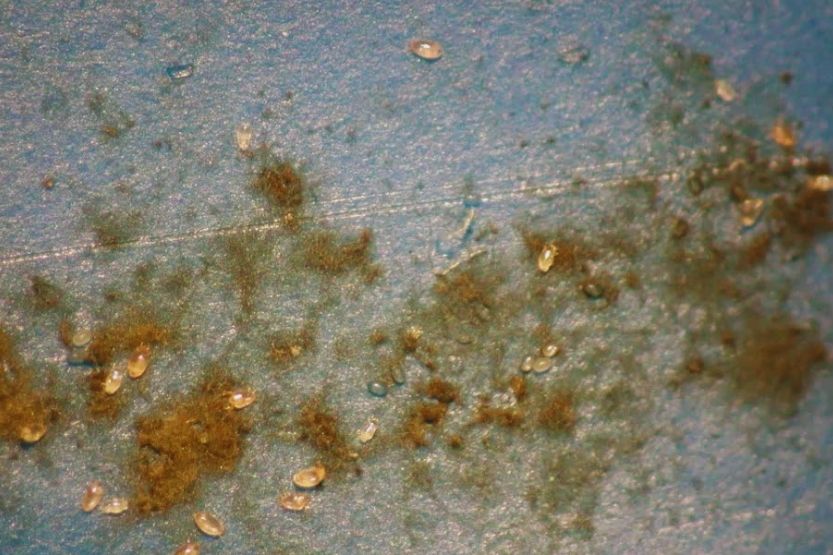
Found in Moist and Damp Environments
Mold mites are commonly found in moist and damp environments. They feed on the molds and fungi that form on the walls and floors. That’s why they’re usually found in bathrooms, basements, and kitchens.
Infest Grains in the Kitchen
Alternatively known as grain worms, they also infest grains stored in the kitchen pantry. They make their homes inside moist electrical appliances, such as refrigerators and dishwashers. Their small, transparent white translucent bodies make them difficult to see like dust.
Not Particularly Harmful to Humans
Mold mites don’t bite and are not particularly harmful to humans. But they do attack grains, and their infestation signifies an unsanitary home. Unfortunately, no known insecticide can get rid of them.
Remove Mold in Your House for Good
So, to eliminate mold mites, you need to remove all the molds and fungus growing in your home. Use a good mold remover spray to rid your house of mold deposits. Install a dehumidifier to reduce the dampness and moisture levels in your home.
Again, what are some of the little white bugs that look like lint? Some of the little white bugs that look like lint include wooly aphids, whiteflies, and mealybugs, which you can commonly find in plants.
5. Whiteflies
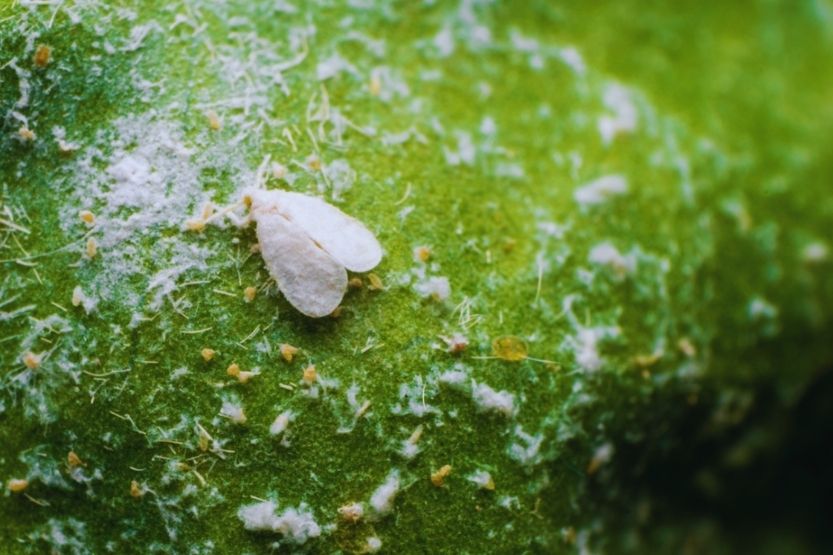
White Oblong Bodies and Visible Wings
Characterized by their white oblong bodies and visible wings, whiteflies are primarily active during the warm summer season. Like wooly aphids, they suck the sap out of vegetables and flowering plants and leave honeydew on leaves and branches.
Harmful to Plants
While whiteflies do not pose a danger to humans, they are harmful to plants. The honeydew they leave behind causes the leaves to get infected, turn yellow, and die.
Not Advised to Use Insecticide Against Whiteflies
It is not advised to use insecticide against them, as it will also kill beneficial insects. These include spiders, dragonflies, and centipedes, which are natural predators of whiteflies. And, of course, it may affect your plants as well.
Make a Soap and Water Spray
To rid your garden of whiteflies the safe way, mix soap and water into a bottle and spray it onto the whitefly-infested leaves on your plants. Be careful not to spray the soap water mixture onto the soil bed.
6. Mealybugs
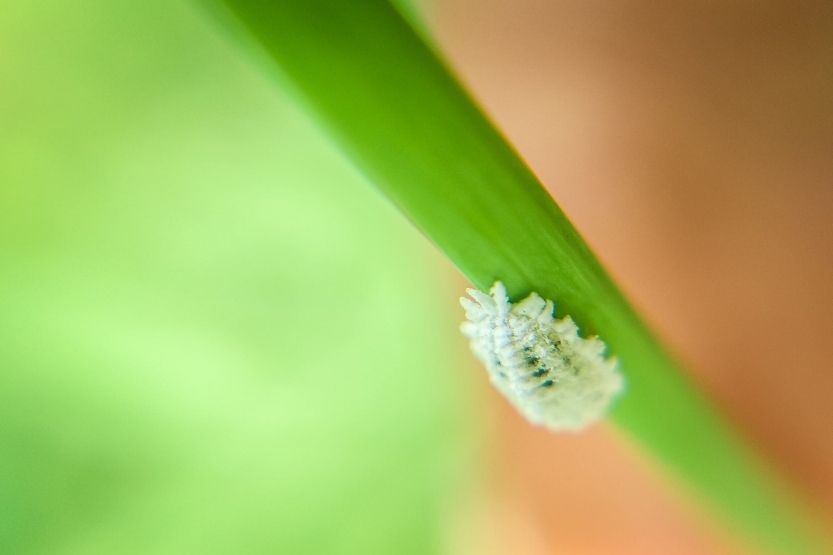
Oval-shaped Bodies
Mealybugs have oval-shaped bodies about a fifth of an inch covered in a waxy coating. They look like white masses of cotton when they pile over one another. Hatching out of their eggs around June, they are active for the remainder of the year. They infest plants in clusters, looking like mounds of cotton on leaves and fruit.
Damaging to Garden
Mealybugs are not dangerous to people but are damaging to your garden. Fortunately, it doesn’t take much to get rid of them. You can quickly drive them away by spraying them with soapy water.
Helper Insects Eat Mealbugs
If there are helper insects in your garden, like dragonflies, spiders, and centipedes, you can let them eat the infesting mealybugs. Or, if you’re patient enough, you can wait for them to die off when summer starts, as the temperature rise is deadly to them.
7. Termites
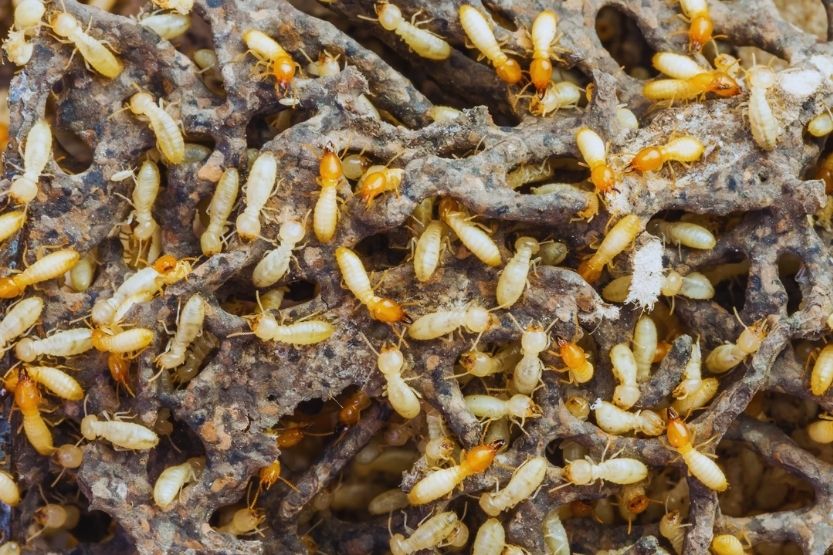
Can Cost You Hundreds of Dollars in House Repairs
Some bugs are dangerous not because they bite people. But because they bite and eat through everything else. Take termites, for instance, which feed primarily on dead plant material, like leaf litter and, most significantly, wood. They can eat you out of house and home and cost you hundreds of dollars in house repairs.
Live Underground
Subterranean termites live underground, and it’s very rare to see them in a home unless there is a severe infestation. They mostly have white bodies, with certain exceptions.
For instance, soldiers, the defenders of the termite colony, are white with orange-brown heads and large jaws. Whereas swarmers, the reproductive flyers, are darker in color rather than white.
Spray Borate
To protect the wood of your home from termites, you can spray borate. It’s a popular termite repellent you can spray onto your furniture, doors, window frames, and other areas before priming and painting them.
Take Termite-infected Furniture Out in the Sun
You can also take termite-infected furniture out in the sun for at least three consecutive days. It will kill the infesting termites and remove the moisture from the furniture. This will prevent re-infestation from occurring.
Call a Pest Control Company
Call a pest control company to carry out the proper inspection and extermination treatment to eliminate termites from your home.
8. Clothes Moth Larvae
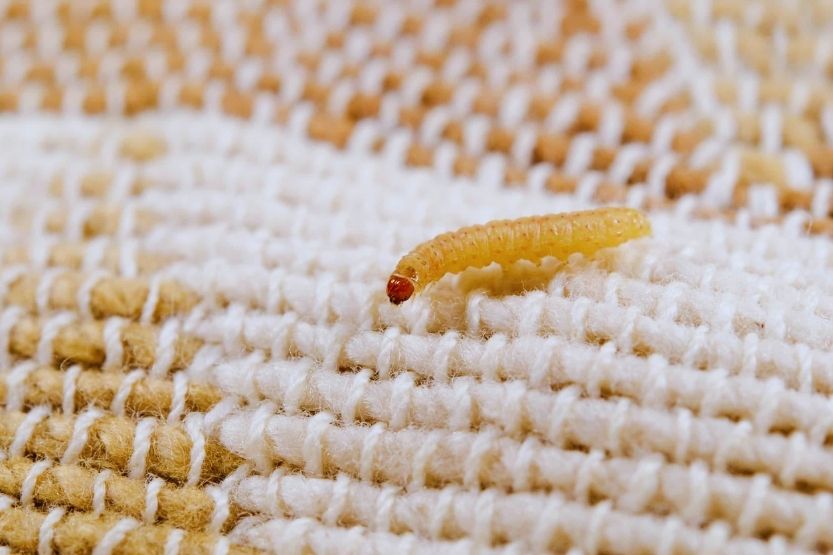
Eat Holes Through Clothing
Webbing clothes moths are so named because they eat holes through clothing. While this is true, it is not the adult clothes moths that do so, but the young. Adult clothes moths measure around three-eighths of an inch in length and are cream-colored. At the same time, their larvae are white and worm-like.
Clothes Are Their Natural Food Source
Feeding on natural fibers, which include animal hair used in fabrics like wool and cashmere, clothing is a natural food source for clothes moth larvae. Unlike most moth species attracted to light, webbing clothes moths are attracted to dark places, such as your closet.
Store Clothes in Vacuum-sealed Plastic Bags
To protect your clothes from getting eaten by larvae, you can store them in vacuum-sealed plastic bags or airtight cotton-lined storage containers. It will keep condensation from setting in to cause molds or mildew.
Thoroughly Clean Clothes
You should also clean your clothes thoroughly as larvae are particularly attracted to clothing with food stains and spills. A radical solution is to place items inside a large plastic bag. Then, leave them in a freezer for seven to ten days to kill eggs and larvae.
Vacuum Closet Regularly
Vacuum your closet regularly to reduce the chance of clothes moth infestation. The smell of cedar blocks also works as a moth-repellant, although it doesn’t kill the larvae. To keep it smelling strong, you also need to sand the wood’s surface every two to three months.
If the clothes moth infestation gets terrible, call in a pest control expert to help you get rid of them.
9. Psocids
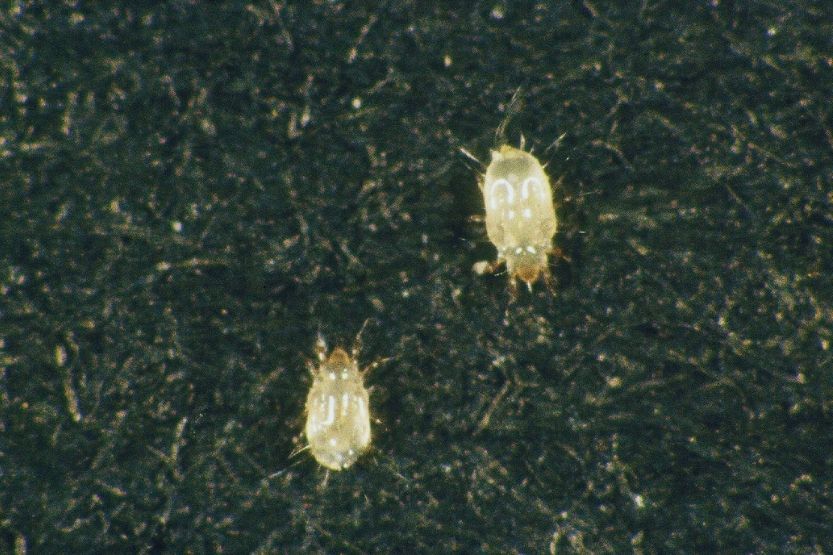
Bark Lice
Psocids are also known as bark lice, but they aren’t lice. They are a wingless outdoor species typically found under tree barks but can also live indoors.
This species ranges from one-twenty-fifth to one-thirteenth of an inch in size. They are cream to pale white and are incredibly tiny, making them difficult to see when indoors.
Live in Dark and Moist Places
Psocids prefer to live in dark and moist places, feed on mold. You can find them in kitchens and bathrooms. Their other name is booklice because you can also find them in damp locations where books are stored. They feed on the glue in books and destroy their bindings.
Feed on Glue in Packaging
Other psocid species feed on the glue in packaging and reproduce in stored products. Despite this, they are relatively harmless to people and are rarely considered pests.
How to Control Bugs in Lettuce
Conclusion – Little White Bugs That Look Like Lint (and Bite)
If you see tiny dust-like creatures occurring at the beginning of every fall season, the chances are that these are aphids. Most of them don’t bite, but other little white bugs look like lint and bite, which appear for the rest of the year. Unfortunately, they could cause serious health risks from allergies and respiratory disorders.
Note that not all little white bugs look like lint bites. But of those that do, there are two kinds you need to worry about: those that bite you and those that bite everything else.
They can pose a threat to your health, your garden, and even your home, and possessions. Some appear like specks of dust, while others are almost invisible to the naked eye, making them difficult to catch.
It’s essential always to keep a clean house to prevent their infestation and take the necessary steps to protect your property from them. Fortunately, many of them can be repelled by simple soap water. But if the infestation gets too much to handle, it’s time to call in a professional pest control expert for help.
Read next:
What Other Kinds of Grey Bugs Are on My Window Sill?

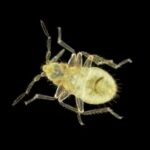
![White Salt-Like Grains in Bed [What Are They?] White Salt-Like Grains in Bed](https://homecarezen.com/wp-content/uploads/2021/12/white-salt-like-grains-in-bed-150x150.jpg)
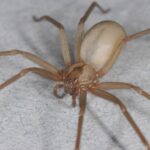
![Tiny Bugs in Bed [Not Bed Bugs] - What Are They? Tiny Bugs in Bed](https://homecarezen.com/wp-content/uploads/2022/01/tiny-bugs-in-bed-150x150.jpg)

